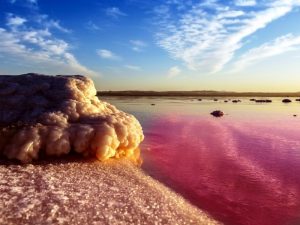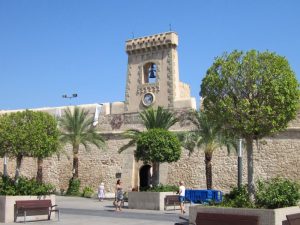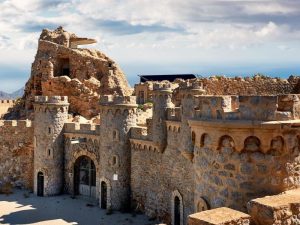NATURE & CULTURE
Guardamar del Segura
More than just beach
 Guardamar del Segura – commonly shortened to Guardamar – is a coastal municipality on the Costa Blanca. Formally, El Raso, where Villa Maya is located, belongs to the municipality of Guardamar. However, the center is 7 km away.
Guardamar del Segura – commonly shortened to Guardamar – is a coastal municipality on the Costa Blanca. Formally, El Raso, where Villa Maya is located, belongs to the municipality of Guardamar. However, the center is 7 km away.
Guardamar usually attracts visitors because of its idyllic beaches, but the city has much more to offer. In addition to 10 white sand beaches, it also has two beautiful parks: Reina Sofia and Parque Alfonso XIII.
Parque Reina Sofia is a varied family park located just behind the seafront promenade. It is a nicely decorated park with many tree species, a beautiful pond with animals and a playground. Across the street starts Parque Alfonso XIII. Here you can take a long walk to the harbor of Guardamar. In fact, it is a large stretch through the dunes of Guardamar, an ideal children's playground.
You will certainly not be bored here. You can start your exploration of the town at El Castillo de Guardamar. This early 12th century Arab fort was heavily damaged in 1829 by a severe earthquake, but today you can still admire the old ring walls and the polygonal floor.
The Rábita Califal is perhaps the most interesting tourist attraction in Guardamar. This fortified monastery complex, dating from 944, has been declared a cultural heritage site and consists of an Islamic monastery and the remains of a Muslim community's housing. The ribat is located in Dunas de Guardamar, a nature reserve not to be missed. The dunes here were formed by sand dispersed from the sea along the town's coastline.
Thanks to the combination of fine sandy beaches, the soft sun and many restaurants offering fresh fish, you can enjoy the Spanish coast to the fullest.
La Mata
Beneficial salt baths
 La Mata is 10 km away. The Salinas of Torrevieja and La Mata are natural parks located in the south of the province of Alicante north of the port city of Torrevieja. Salinas literally means salt mines. La Mata is Europe's main salt supplier.
La Mata is 10 km away. The Salinas of Torrevieja and La Mata are natural parks located in the south of the province of Alicante north of the port city of Torrevieja. Salinas literally means salt mines. La Mata is Europe's main salt supplier.
A visit to the salt mines is highly recommended. The salt lakes are a benefit to the skin and are particularly popular with people with heart problems, rheumatism, arthritis or asthmatic conditions. Rumor has it that the salt lake's "healing powers" alleviate the pain.
The park has numerous walking and cycling routes. Rest areas with tables and benches are provided. Climb the watchtower to admire the beauty of the Spanish countryside.
The longest beach in the north of the city is “La Mata”. Its water is crystal clear and there are many dunes.
Elche
A palm forest in the city
 Elche is located at 30 km and is known as palm city. Thanks to the Palmeral, a palm tree forest in the middle of the city, Elche is a UNESCO World Heritage Site. With about 600,000 trees, it is by far the largest palm garden in Spain. It gives an exotic atmosphere to the city. The trees are grown in botanical gardens, one of which is open to the public: the botanical Horta del Cura, a beautiful piece of nature.
Elche is located at 30 km and is known as palm city. Thanks to the Palmeral, a palm tree forest in the middle of the city, Elche is a UNESCO World Heritage Site. With about 600,000 trees, it is by far the largest palm garden in Spain. It gives an exotic atmosphere to the city. The trees are grown in botanical gardens, one of which is open to the public: the botanical Horta del Cura, a beautiful piece of nature.
Elche is a cozy city with many nice streets where one can enjoy shopping, have a drink on a sunny a terrace or eat tasty tapas. Discover a different side of the Mediterranean as you walk among the thousands of palm trees, see impressive monuments and relax on the beach. The beautiful Parque Municipal is free. You will find a lot of animation here and of course ... palm trees.
In August, the famous Misteri d'Elx is performed, a medieval play about the Assumption of Mary. The performance is held in the Basílica Menor de Santa María de Elche. This monumental building has a tower offering a great view over the palm forest.
Don't miss the Baños Árabes in the cellars of the Convento de la Merced. These Arab baths are rare remnants of the region's Islamic architecture.
Santa Pola
16th century castle, Las Salinas & el palmeral
 Santa Pola is 24 km away. The sea has long left its mark on culture, economy and gastronomy. It once had one of the largest fishing fleets in the entire Mediterranean region. Plagued by pirates, a fortress and watchtowers were supposed to provide protection. The 16th century castle is located right in the center of Santa Pola and has grown into a cultural center with museums and an exhibition hall. The flora and fauna of the beloved Mediterranean Sea are central to the Aquarium Municipal.
Santa Pola is 24 km away. The sea has long left its mark on culture, economy and gastronomy. It once had one of the largest fishing fleets in the entire Mediterranean region. Plagued by pirates, a fortress and watchtowers were supposed to provide protection. The 16th century castle is located right in the center of Santa Pola and has grown into a cultural center with museums and an exhibition hall. The flora and fauna of the beloved Mediterranean Sea are central to the Aquarium Municipal.
The area around Santa Pola is an ecologically diverse region with beautiful beaches, salt marshes and the Sierra de Santa Pola Mountains. The mountain consists mainly of pine trees. Today there is a lighthouse and the remains of a watchtower. The island of Tabarca, which lies off the coast of Santa Pola, is a protected natural area. It is therefore very popular with divers.
Nature reserve Las Salinas is definitely worth a visit. All kinds of migratory birds such as flamingoes and storks hibernate here. Numerous other bird and duck species feel equally at home here. This is an ideal place for a spectacular sunset. For a green environment, go to Parque El Palmeral: palm trees, ponds, waterfalls, bridges, flowers, playgrounds, an auditorium and the ruins of a luxurious Roman villa. You have come to the right place for romantic walks.
Most beaches were awarded the blue flag: beautiful and safe beaches with shallow water and pure soft sand. Along the beaches is a beautiful boulevard, dotted with cafes and restaurants, which takes you to the port of Santa Pola.
Both the beaches and the surrounding nature offer numerous sports options: beach volleyball, basketball, handball, tennis, golf, paragliding, hang gliding and gliding, mountain biking, scuba diving, sailing, rowing, windsurfing, canoeing, kite surfing, jet ski, sailing, …
And the weather? The Cape of Santa Pola protects the bay from the strong east winds and ensures a mild climate.
Torrevieja
Beach, water sports, golf, shopping and much more

Torrevieja is just 10 minutes from Villa Maya. The city is known for its beautiful sandy beaches, but also for the liveliness of the neighborhoods and the variety of activities. This makes the area very popular with tourists and Spaniards who come to spend their holidays here from other parts of Spain.
In the south of the city is Cala Ferris, a landscape formed by palm trees and small golden dunes. The crystal clear sea provides for the best swimming.
In Torrevieja you will also find La Zenia Boulevard, the largest open-air shopping center in Spain. With more than 150 shops, restaurants, terraces and a playground, it is definitely worth a visit!
All kinds of water sports, water parks, karting and golf are also possible. An ideal mix of adventure and Spanish culture.
Alicante
Bustling capital of the Costa Blanca
 Alicante is 43 km away. Being the capital of the Costa Blanca, it has a beautiful sea promenade that forms the lively and cozy centerpiece by the stalls and street theater. At the end of the promenade is the beach that exudes a holiday atmosphere all year round. The skyline of this bathing and wintering place is dominated by the impressive Santa Barbara church.
Alicante is 43 km away. Being the capital of the Costa Blanca, it has a beautiful sea promenade that forms the lively and cozy centerpiece by the stalls and street theater. At the end of the promenade is the beach that exudes a holiday atmosphere all year round. The skyline of this bathing and wintering place is dominated by the impressive Santa Barbara church.
The Castillo de Santa Barbara is located 166 m above the city. This castle is the main attraction of Alicante and one of the largest castles in Europe. Follow the hiking trail through the pine forests and extensive parks on the way to the top. Upstairs, you will be rewarded with one of the region's most spectacular views. Explore the castle and discover the ruins of the original church, a large moat and a series of cannons that used to protect the city. Inside the huge castle you will find a watchtower, dungeons and a palace.
The old City of Alicante is small and cozy. Here you will find most monuments. The Santa Cruz district is a set of narrow picturesque streets with steps surrounded by white houses, richly garnished with flowers and decorated tiles
Alicante harbor is the gateway to many attractions. Numerous operators offer cruises and charters in the port. Pass the day on a catamaran exploring the coast or spend an hour on the ferry to the nearby island of Tabarca. There is a lot to see and discover before boarding. Stroll along the palm-lined Explanada de España and choose from the many authentic tapa bars.
Enjoy a drink at sunset and watch the sky change color over the Mediterranean. Go to one of the beach bars on the harbor. Here you will find several traditional restaurants where you can taste fresh fish, fish soup and paella. Around midnight, the Old Town turns into one of the most popular places for drinking, dancing and partying.
Playa Postiguet is exceptionally neat and clean. It is an ideal family beach with shallow water that stays warm all year round. If you prefer water sports, Playa de San Juan is a must.
Murcia
Pearl of the South
 Murcia is 55 km away. The city is sometimes called the pearl of the south. Its versatility in architectural styles adorns beautiful buildings, castles, churches and museums. The city has approximately 450,000 inhabitants and has experienced enormous growth in recent decades. Murcia has a long, interesting history and today it's a lively tourist city full of culture, good food and a vibrant student and nightlife.
Murcia is 55 km away. The city is sometimes called the pearl of the south. Its versatility in architectural styles adorns beautiful buildings, castles, churches and museums. The city has approximately 450,000 inhabitants and has experienced enormous growth in recent decades. Murcia has a long, interesting history and today it's a lively tourist city full of culture, good food and a vibrant student and nightlife.
Murcia is known for the many bridges over the river. Take a walk and be surprised by the many different styles. Plaza de Belluga takes you to the famous historical streets of the city, the Traperia in which the beautiful Real casino de Murcia is located with its beautiful library and dance hall where concerts are regularly held.
The Plateria is rich in historical buildings where large Spanish banks, department stores and shops are located. Via narrow streets you reach cozy squares with bars and restaurants. Here you can enjoy local and regional traditional dishes. One of the most lively and famous squares in the city is Plaza de Flores in the old city center. Flower stalls and shops make the square very popular.
Along the banks of the river Segura, the turning dike takes you to Plaza Glorieta, one of the most popular squares where the town hall is located. Be sure to visit the Santa Maria cathedral, the Roman Theater, the old Santa Clara monastery and the Almudí palace.
Taste the covered fresh market Mercado de Veronicas and settle down on the Plaza de Julián Romea or the Plaza Hernández Amores. In addition, the city is known for its orchards, but also its fruit and vegetables that are exported to all of Spain and Europe.
Cartagena
Melting pot of history, art & culture
 Cartagena is 75 km away. This port city on the south-east coast of Spain was founded about 3,000 years ago by the Phoenicians but has also been owned by the Romans, Moors and Christians. It is a city where history, art and culture come together.
Cartagena is 75 km away. This port city on the south-east coast of Spain was founded about 3,000 years ago by the Phoenicians but has also been owned by the Romans, Moors and Christians. It is a city where history, art and culture come together.
The most famous building is the Roman Amphitheater. You will also find remains of the Punic Wall, the stands of an old Roman theater and the eighteenth-century city wall along the sea. Do you like modernist architecture? Check out the town hall of Cartagena, Aguirre palace, Casino, Gran Hotel and train station.
Interesting local festivities include the feasts for the patron saint of Yecla (December), the Fiestas de la Vera Cruz in Caravaca de la Cruz (early May), the Cuadrillas de Barranda festival, the Semana Santa of Lorca and the Fiesta de Carthagineses y Romana, a unique event where locals and tourists take a seat on the central stage to portray the history of Greek and Roman rule.
Given its rich history, Cartagena is a melting pot of cultures and this is reflected in art. You can discover them in the Museo Nacional de Arqueología Subacuática, the Casa de la Fortuna and the Augusteum to the Castillo de la Concepción. Buildings worth visiting are the Casa Maestre, with Baroque elements inspired by Gaudí's Casa Calvet in Barcelona, the Palacio Consistorial with French Baroque elements and the Casa Cervantes, with the typical balconies in Cartagena style.
In addition, Cartagena has a strong reputation as the Spanish municipality with the most awarded beaches. It features nearly forty kilometers of swimming areas and pristine beaches, including the beaches of Parque Regional de Calblanque. So you have plenty of opportunities here to enjoy fun water sports all year round. Thanks to the colorful underwater life, it is a great destination for divers.
